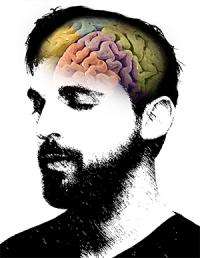Scientists open new window into the brain

(Medical Xpress) -- An unexpected discovery has led scientists to open an intriguing new window into the human brain, via the visual system.
Their finding may have implications for better understanding of states such as sleep, epilepsy and anaesthesia say the research team leaders Dr. Sam Solomon and Professor Paul Martin of the Vision Center and the University of Sydney.
Potentially it could open up a new pathway for manipulating brain rhythms to manage disorders such as insomnia and epilepsy, the team speculate in an article published in the Proceedings of the National Academy of Sciences.
"It was purely a chance observation we made while we were activating the three cell layers of the lateral geniculate nucleus (LGN), which is the part where the optic nerve actually connects to the brain," Professor Martin recounts.
Two of these layers are linked with our ability to perceive edges and movement, he explains. The third, koniocellular or 'K' layer, is much more primitive - part of our deep evolutionary ancestry - and its function is still mysterious.
"When we stopped applying a stimulus, two of the three layers ceased to respond while the K layer continued to pulse, slowly and rhythmically - like a sleeping brain."
At the suggestion of a colleague, the research team then compared the signal from the K cells to an EEG readout from the brain itself: "To our surprise and delight we found the two were marching in time," Dr. Solomon says.
The observation has provided physical evidence to support a scientific theory that the more primitive parts of the brain serve as regulators for the more advanced parts, responsible for conscious thought and feelings.
It could also lead to a deeper scientific understanding of the nature of sleep and unconsciousness.
However an intriguing idea is that this pathway might also be used to influence the patterns of the brain itself, Professor Martin adds.
"We know this K pathway is affected by blue light. This raises the tantalising possibility that by stimulating it with light of the right wavelength you could actually alter the rhythms of the brain."
The slow theta rhythms of the brain, as seen on an EEG, are commonly associated with sleep, anaesthesia and epilepsy, he says.
"Just possibly, the K cells might offer a way to use visual stimuli to alter brain rhythms - to modify sleep patterns, say, or to arrest or prevent an epileptic state. At this stage it is simply an idea flowing from our discovery - but it is well worth exploring further."
More information: Slow intrinsic rhythm in the koniocellular visual pathway, PNAS, Published online before print August 15, 2011, doi: 10.1073/pnas.1108004108 www.pnas.org/content/early/201 … /1108004108.abstract
Abstract
Slow rhythmic changes in nerve-cell activity are characteristic of unconscious brain states and also may contribute to waking brain function by coordinating activity between cortical and subcortical structures. Here we show that slow rhythms are exhibited by the koniocellular (K) pathway, one of three visual pathways beginning in the eye and projecting through the lateral geniculate visual relay nucleus to the cerebral cortex. We recorded activity in pairs and ensembles of neurons in the lateral geniculate nucleus of anesthetized marmoset monkeys. We found slow rhythms are common in K cells but are rare in parvocellular and magnocellular cell pairs. The time course of slow K rhythms corresponds to subbeta (<10 Hz) EEG frequencies, and high spike rates in K cells are associated with low power in the theta and delta EEG bands. By contrast, spontaneous activity in the parvocellular and magnocellular pathways is neither synchronized nor strongly linked to EEG state. These observations suggest that parallel visual pathways not only carry different kinds of visual signals but also contribute differentially to brain circuits at the first synapse in the thalamus. Differential contribution of sensory streams to rhythmic brain circuits also raises the possibility that sensory stimuli can be tailored to modify brain rhythms.













